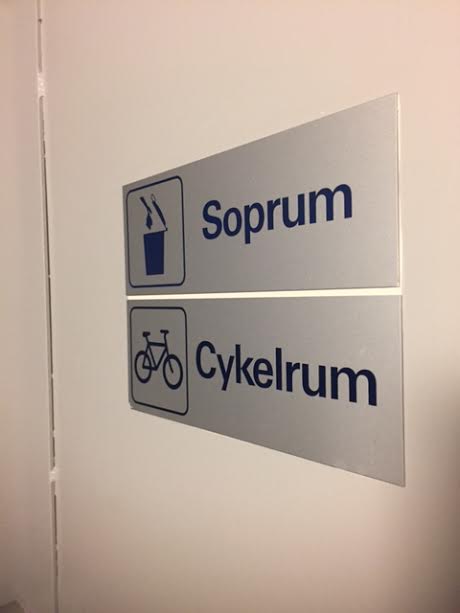Foreign to Familiar: How to “Language Proof” Your Immediate Environment
Sometimes, when you’re surrounded by a new language it can overwhelm your capacity to pick up new things. It’s almost too much newness, and you just draw a line. Everything from the toothpaste to the billboards to the TV is filled by the unrecognizable.
You end up looking at words and noting that you’ve seen them before but still not bothering to figure out what they mean.
These ignored words remain foreign – and blocking your eyes and ears in this way means you’ll never become fluent.
If you continue this way, you run the risk of ending up with what we’ll call language fatigue.
What can you do about it?
The obvious solution: make the foreign familiar and do it as ‘soon as you land’.
What Causes Language Fatigue?
So many people live overseas, are effectively “immersed” in the local language, yet they can only speak a handful of words.
How does this happen?
Learning a new language is as much about mindset as anything else. If you fall into the trap of language fatigue, you hone a mindset that’s resistant to learning.
And the more of a beginner you are, the more you’re likely to feel overwhelmed by how much you don’t know. Beginners are most likely to suffer with this kind of ‘language resistance’, which is why it can be so tricky to break through the beginner bubble.
You have to be wilful about taking on the challenge of a new language. When trying to learn a new language by immersion, it’s easy to underestimate yourself and think “I’m just a beginner.” This defence makes you okay with not knowing certain things. However, if you don’t move past this mindset, you will always be a beginner, an outsider.
The same thing can happen for intermediate learners too… though it’s easier for them to make a breakthrough as more things are familiar.
Wherever you’re at, if you put it just a bit of effort it’s surprising how looking close to home can make a huge difference in making the foreign familiar.
Step 1: Decide to Break the Loop
The moment you get stuck in the habit of blocking out what’s around you you stand to fail at your language learning goals.
If you are blocking, it’s time to dive back in. If you’ve just arrived in a country with a new language, start to soak up the written words around you now.
Step 2: Start Language Proofing in Manageable Doses
It’s obvious you can’t learn everything at once, so you have to be both clever and patient. This means starting with manageable doses of new words. Ideally, these should be words you see every day. You want to work close to home. That’s the key trick in gaining familiarity in a new place.
In fact, start in your dwelling first. You want to focus on words you see often.
I call this process language proofing.
Perhaps there are mystery words on something in your house? Food packages you buy? Or a sign near your front door you pass frequently?
Stop walking past. Translate them, whether by yourself or by asking a native speaker.
It’s easy enough to start: Take 30 minutes and log everything in your house and the immediate environment around your home.
For example, if you live in an apartment building, this might be looking at the words on the elevator or the communal mailboxes or the instructions for using the laundry room.
No matter how rare they are in “everyday” use, the fact is that you see these words every day and you should know what they mean. It won’t take long to figure them out and you’ll have taken a big step in your mission of turning foreign into familiar.
Language proofing your environment in this way has a couple of effects.
First, it builds your confidence. As you language proof your environment, you’ll start to recognise every word you see in your day-to-day life. If you routinely walk past unknown words it keeps your brain set on ‘outsider mode’. Language proofing switches your mind to ‘insider’. It’s a huge mindset shift. And you’ll realise that you can learn a language!
Second, you are actively telling your brain you are ready and willing to absorb the language you see. It opens your mind to taking up yet more words by reinforcing a sense of linguistic familiarity.
Doing this language reconnaissance, as early as possible after you arrive in a new country, will have a huge pay off.
When you walk out your door, you’ll understand all the words you pass as they’ll all be in your recognition vocabulary. This will give you a notion of fluency in your target language, even if it’s just ‘around home’. When you’re new to a language, any fluency counts big time.
What you are building is your recognition vocabulary and it’s a key part of accepting a language as your own.
Step 3: Get Your Camera Out and Go on a Word Hunt!
You’ve got yourself into the language proofer’s mindset, and you’ve language proofed your immediate environment. Now stay on your word hunt! Keep seeking out new words.
My favourite way of doing this is with my camera as it lets me refer back to these words and track my progress.
Scour your surroundings and take photos of all the words you encounter.
You can translate the words in your images using your smartphone and Google Translate. Google Translate will store your translations so you can export them to a word log or flashcard deck. Alternatively, as you hunt down words, have your dictionary on hand. Even better, walk your route with a native speaker who’s willing to help you.
Step 4: Learn from Context
The best part of building a recognition vocabulary is that it’s often highly contextual. It’s context that builds familiarity, along with use.
What’s more, context can help you work out the meaning of new words for yourself. This is what helps the words stick in your memory.
Can you read the sign in this image:

This sign is found on the door of a room in the basement of an apartment building in Sweden. You probably have a guess from the form of the words you see, but especially from the pictures and when you open the door you see it’s a storage room for people’s bikes. Plus the adjoining room has all the recycling bins and trash dumpster.
You can probably easily guess that the top word has to do with trash and the second with bikes. Since it’s Swedish, a Germanic language like English with lots of similar words, you might guess correctly that rum is “room”. Sopor is “garbage” in Swedish, so soprum is the “trash room”. Cykel is “bike”, so cykelrum is the “bike room”.
Once you know the meaning, you’ll look at the sign differently. Every time you enter this room to get your bike or sort the recycling you are reactivating your Swedish vocabulary.
At risk of labouring the point: There’s no excuse for not learning the meaning of this sign if you are going to pass through this door on a regular basis. Do this for all the words in your vicinity.
Step 5: Look Out for Online Ads
Another space you can language proof is social media and the internet, by translating ads as they appear. For example the sponsored ads in your Facebook newsfeed.
Consumerism is not the point here! Rather, see it as an opportunity to create another safe space of language familiarity.
At first, it will seem easy to ignore ads. We’ve all trained ourselves to do this. So untrain yourself. Stop for a moment when you first log onto social media to take in those “pesky” ads.
Ads are actually great for language learning. They’re short and sweet, contain lots of repetition, and feature real life things that are helpful for you to know. Whether it’s shoes, food, or dating, this is a core working vocabulary for functioning in the world.
Facebook will even translate the text for you, and while you have to take these translations with a (big) pinch of salt, you’ll certainly get the gist and learn new words.
Plus if you copy ads into the Google Translate app on your smartphone, you can ‘star’ any of them you want to come back to. This builds up a running list of memorable words ready to review any time.
Increasingly, you’ll build an ad-recognition vocabulary. You’ll be reading ads all around you as you would in your native language. It’s a great feeling when you can decipher many of these without any help.
As with signs, ads contain contextual clues that aid in understanding them. Sometimes you’ll learn vocabulary from the picture. Other times, you might be able to make out the words because you’ve already seen the exact same ad in English.
Ads are also particularly easy because we know innately what ‘ad language’ looks and sounds like. They are trying to compel you to buy something. When you know the focus of a passage of text from the outset, it’s far easier to hone in on the meaning.
Look at these two ads:

You can probably guess from the first ad that klackar are “heels”. This “guessing” is how we naturally learn our native language, through context. No one explains what a cat or dog is to us when we are small. They just point to one and say the word and we figure it out.
Reading ads is also good for judging how different the word order and usage of verbs and other parts of language are from English. The literal translation of this ad is: “4 tips for to get style with heels”. Notice the word order “for to get”, which is very Swedish.
In addition to seeing images that you can match to words, you might even have seen the ad in English before and therefore it’s perfect for reading in your target language. The second ad is running in English and Swedish and literally means: “This here App can teach you a language in only 3 weeks”. Notice the ‘this here’, which is very Swedish. Again, somewhat different in structure than English.
Step 6: Rigorously Apply the Twice Seen Rule
In time, you can increase the size of your language-proofed zone, going beyond your immediate environment to your wider world. This builds an ever-growing corridor of familiarity – the places you can go where you understand the words that are all around you.
If you ride the tram every day, take pictures and translate all the words you see on the ticket machine. If you often eat at the same restaurant, take a photo of the menu, then translate it when you’re back at home — or ask the wait staff for help. It’s a great conversation starter, and you’ll feel more like a local the next time you are there.
But how do you know which words to language proof next?
If it’s in your path, snap it and learn it. In general, the trick is to live by the ‘twice seen’ rule: if you’ve seen a word twice, you’ll be sure it see it many more times. Learn it.
Step 7: Become a Language Proofing Pro
What are the big draws for visiting or living in a foreign place? For many people, these are novelty, fresh perspectives and the chance to learn. The problem: too much ‘foreignness’ can get in the way of learning. You can end up blocking the ‘foreign’ out because you can’t make sense of it.
That’s why it’s important to keep language proofing your environment. You have a lot to gain by doing so, especially once you start reading the ads around you. Here the vocabulary starts to overlap with keywords you’ll want to use in conversation as well.
Also, remember that in language proofing your environment, you’re building your recognition vocabulary rather than your active vocabulary.
Remember that recognition vocabulary is just that – recognition only. It goes to building familiarity, and minimizing the ‘foreign’ trigger that reduces your motivation to absorb new words.
Later, you can start working on embedding your language proofed words into your speech.
Your Turn: Share your Experiences of Language Proofing
Being familiar with the language of your surroundings will help you fit right in, just like you do at home.
That’s why I recommend that you learn the words you encounter frequently. Once you do, and see them again and again as a natural part of your day, you are well on your way to making the foreign familiar.



Social